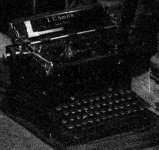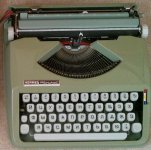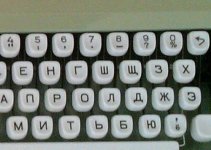You are using an out of date browser. It may not display this or other websites correctly.
You should upgrade or use an alternative browser.
You should upgrade or use an alternative browser.
W/NW Typewriters and Printing Presses
- Thread starter lynnb
- Start date
- Latest activity Latest activity:
- Replies 56
- Views 5K
Phil_F_NM
Camera hacker
Circa 1924 Corona Four.

Contemporary Olympias from left: 1966 SM9 DeLuxe (Wide), 1964 SF DeLuxe.

Phil Forrest

Contemporary Olympias from left: 1966 SM9 DeLuxe (Wide), 1964 SF DeLuxe.

Phil Forrest
Pál_K
Cameras. I has it.
Below is a Hermes portable, the very first typewriter I ever bought - I was about 17 years old. A friend of my father, a nice Italian man who liked me, gave me a fair bit of money to add to my savings to buy it. I have it to this very day.
Also, is an LC Smith which my father found - it was unusual in that the keys were all black. Perhaps it was used in a school to teach typing. It was extremely heavy, but I truly enjoyed this typewriter. Sadly, I believe it was given away when we moved. Sorry for the poor image quality - this is a very extreme crop from a 40+ year-old photo.
Also, is an LC Smith which my father found - it was unusual in that the keys were all black. Perhaps it was used in a school to teach typing. It was extremely heavy, but I truly enjoyed this typewriter. Sadly, I believe it was given away when we moved. Sorry for the poor image quality - this is a very extreme crop from a 40+ year-old photo.
Attachments
dourbalistar
Buy more film
Nikon FM2n, AI Nikkor 50mm f/1.8S, Kentmere Pan 400, developed in LegacyPro L110 at 1:31 for 5.5 minutes.

2024.02.25 Roll #351-08563-positive.jpg by dourbalistar, on Flickr

2024.02.25 Roll #351-08563-positive.jpg by dourbalistar, on Flickr
Disappointed_Horse
Well-known
JoeV
Thin Air, Bright Sun
Bob Michaels
nobody special
A Floridian's view of the printing press business:
1895: Cleveland Ohio based Harris Corp. develops high speed printing press and becomes major manufacturer
1967: Harris Corp. acquires Radiation Corp. a small Melbourne Florida based technology company
1978: corporate headquarters moved from Cleveland Ohio to Melbourne Florida
1996: Harris Corp. sells off it's remaining printing press business
current: L3 Harris is a $16 billion technology company
1895: Cleveland Ohio based Harris Corp. develops high speed printing press and becomes major manufacturer
1967: Harris Corp. acquires Radiation Corp. a small Melbourne Florida based technology company
1978: corporate headquarters moved from Cleveland Ohio to Melbourne Florida
1996: Harris Corp. sells off it's remaining printing press business
current: L3 Harris is a $16 billion technology company
Bob Michaels
nobody special
Cueto, Cuba 2015 - Harris Corp. hot lead typesetter and printing press in government printing office. This machine produced individual alphabetic characters out of hot lead and aligned them with spaces to create individual lines of text which then were stacked to create a die to print an entire page of text. I am told one of these is in the manufacture's museum.


CMur12
Veteran
I just got a Minolta MD adapter for my LUMIX S5ii and tried it out with the Minolta 58/1.2. The subject is a Singer brand electric typewriter, made by SCM (Smith-Corona Marchant). Yes, too much bokeh, but this will be a good portrait lens.
View attachment 4840108
I never saw a typewriter with the Singer brand, though I certainly remember Smith-Corona.
- Murray
PS. Go Minolta!
JoeV
Thin Air, Bright Sun
SCM (Smith-Corona Marchant) also made typewriters for Sears, which were often better styled than their name-brand cousins.I never saw a typewriter with the Singer brand, though I certainly remember Smith-Corona.
- Murray
PS. Go Minolta!
In the 1920s, L.C. Smith & Sons merged with Corona (that started as the Standard Typewriter Company) to form Smith-Corona. In the early 1960s, Smith-Corona bought Marchant, the calculator company, to form SCM.
JoeV
Thin Air, Bright Sun
 Corona 3 by Joe Van Cleave, on Flickr
Corona 3 by Joe Van Cleave, on FlickrThis is a 1930 Corona 3 Special. It’s a folding typewriter. This brand started around 1906 with the Standard folding typewriter, then around 1914 they changed their name to Corona. These were popular with the British Army in the trenches of WW1, for officers to write their daily field reports, they were one of the few small portables in high volume manufacture.
The “3-bank” Corona has only three rows of keys, but each key could print three characters, because each type bar had three type slugs, not the standard two. There’s lower case, then a CAPS shift key for upper case, and a FIG shift keys for numbers and symbols. This Special model had extra CAPS and FIG shift keys on the right side of the keyboard. It also has a backspace key, margin release, bichrome (red or black) ribbon setting and single or double line spacing.
I’ve had the platen roller and feed rollers re-covered in new rubber, and the carry case has been redone also.
JoeV
Thin Air, Bright Sun
Disappointed_Horse
Well-known
Interesting. I never knew such things existed.
dave lackey
Veteran
CMur12
Veteran
Just found this thread…😳
Thought I would share my 1955 Smith Corona. Still using it and still loving this wonderful machine.😊
Dave View attachment 4840165
That's a nice one! Preset tabs were a deluxe feature in a portable.
- Murray
Dan
Let's Sway
Where in the heck are you guys finding new ribbons to use?
JoeV
Thin Air, Bright Sun
Ribbons Unlimited (443-857-3615) is a great place, call Lanie and tell him what machine and model and he’ll make sure they have the right spools. They usually come with one spool, you attach the new ribbon to a blank spool after removing the old ribbon, but you can also specify that you want the ribbon already with two spools. I also buy in bulk from Baco Ribbon and Supply, I buy the 330 yard black/red reel and respool the ribbon for each typewriter, this is more economical for me because I have 40+ machines!
agentlossing
Well-known
I should dig up some photos of my Olivetti Lettera 35, and take a few of the (very mint) Olympia which I bought a while back. I've actually been wanting to use the Olympia, pulled it out of storage, and have it waiting for a ribbon. I got some ribbons which are black and red, I will have to see if this typewriter is configured for them, or if it needs a solid black ribbon.
My family was a bit behind the times, so in the late 80s to early 90s, as a child, I learned typing on Brother electronic typewriters, since I did not have access to any computers. I've got quite the soft spot for them.
My family was a bit behind the times, so in the late 80s to early 90s, as a child, I learned typing on Brother electronic typewriters, since I did not have access to any computers. I've got quite the soft spot for them.
CMur12
Veteran
SCM (Smith-Corona Marchant) also made typewriters for Sears, which were often better styled than their name-brand cousins.
In the 1920s, L.C. Smith & Sons merged with Corona (that started as the Standard Typewriter Company) to form Smith-Corona. In the early 1960s, Smith-Corona bought Marchant, the calculator company, to form SCM.
I just pulled out a nice "Smith-Corona" typewriter from the 1960s that a friend recently gave to me. Sure enough, it is branded SCM!
Mine is a manual, but I wouldn't mind picking up one of the electric models as a complement. They were very nice machines, too.
Thanks for the history.
- Murray
Guth
Appreciative User
I like the feel of this shot. Bonus points for including a lava lamp in the background!Corona 3 by Joe Van Cleave, on Flickr
This is a 1930 Corona 3 Special. It’s a folding typewriter. This brand started around 1906 with the Standard folding typewriter, then around 1914 they changed their name to Corona. These were popular with the British Army in the trenches of WW1, for officers to write their daily field reports, they were one of the few small portables in high volume manufacture.
The “3-bank” Corona has only three rows of keys, but each key could print three characters, because each type bar had three type slugs, not the standard two. There’s lower case, then a CAPS shift key for upper case, and a FIG shift keys for numbers and symbols. This Special model had extra CAPS and FIG shift keys on the right side of the keyboard. It also has a backspace key, margin release, bichrome (red or black) ribbon setting and single or double line spacing.
I’ve had the platen roller and feed rollers re-covered in new rubber, and the carry case has been redone also.









